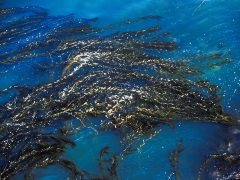Features
Material advance for seaweed
Date: 2017-10-13 11:03:16.0
Author: Jon Evans

Many research groups have investigated the potential of using seaweed, or macroalgae, as a biofuel feedstock (see Seaweed surprise). The latest is a group from the Woods Hole Oceanographic Institution in the US, which has just received $5.7 million from the US Department of Energy’s Advanced Research Projects Agency-Energy (ARPA-E) for two projects aimed at advancing the mass production of seaweed for biofuels and bio-based chemicals.
The first project will use the latest gene sequencing and genomic resources to develop a breeding program for sugar kelp (Saccharina latissima), with the aim of enhancing biofuel-related traits. The second project will develop an autonomous underwater observation system for monitoring large-scale seaweed farms for extended periods of time without human intervention.
According to ARPA-E, the commercial farming of seaweed could yield about 300 million dry metric tons per year, which has the potential to meet around 10% of the annual US demand for transportation fuels. But this seaweed could find other applications as well, because recent research has shown that it can also be used to produce some highly useful materials.
One approach to producing materials from seaweed is simply to heat it in the absence of oxygen, known as pyrolysis, which converts it into a carbon-rich material similar to graphite. Scientists have already done this with many other natural materials, including pollen and banana peel (see Charging up biological batteries). But brown seaweed, which includes S. latissima and is what most people think of as seaweed, allows for a little twist on this process.
This is because brown seaweed is primarily made up of a polysaccharide known as alginate. Now the great thing about alginate is that it’s covered in carboxyl and hydroxyl groups that readily bind with metal ions, offering a handy way to tailor the properties of the carbon-rich material. A team of scientists led by Dongjiang Yang at Qingdao University in China have done this with various metal ions, including iron, cobalt and nickel anions. Attaching the anions to alginate and then heating it in a nitrogen atmosphere produced carbon-rich materials with an egg-box structure, in which the anions are surrounded by a layer of graphitic carbon.
These metal/carbon composites are interesting in their own right, but they become even more interesting if the metal anions are subsequently removed by a strong acid. This produces a highly porous carbon material that Yang and his colleagues have shown can be used to produce battery electrodes and supercapacitors. It even makes a metal-free catalyst for splitting water, potentially offering a much cheaper alternative to the platinum-based catalysts that are the best current option.
Yang and his team first reported this work in a paper in ACS Central Science in 2015. But they have since gone on to use the same basic approach to produce various other materials from seaweed, as they revealed in a presentation at a national meeting of the American Chemical Society in April of this year. This includes a material comprising iron oxide nanoparticles embedded in a seaweed-derived graphene aerogel that displayed a high capacity for storing lithium, making it of potential use as an electrode in lithium-ion batteries.
A different approach to producing materials from seaweed has been adopted by a team of scientists from Italy, led by Athanassia Athanassiou at the Italian Institute of Technology in Genova. Rather than heating seaweed, Athanassiou and her team dissolve it in trifluoroacetic acid (TFA) and then combine it with small amount of cellulose to produce a thin film.
As reported in a paper in Algal Research, when they tried this out with species of red, brown and green seaweed, they were able to produce films with a range of different physical properties. But all of them were biocompatible and all possessed a high antioxidant capacity, while the thin film produced from brown seaweed also displayed anti-inflammatory properties, and so Athanassiou suggests they could make ideal medical materials.
The views represented here are solely those of the author and do not necessarily represent those of John Wiley and Sons, Ltd. or of the SCI.
Displaying 6 keywords used to tag this article:
- Official Jimmy Choo Victoria Camel
- Mont Blanc Ball Point Pen 132 [5df5
- Christian Louboutin Botas : Christi
- Datejust Lady 31
- Replica PID 00942:Breitling Chronom
- Glashutte Horloges
